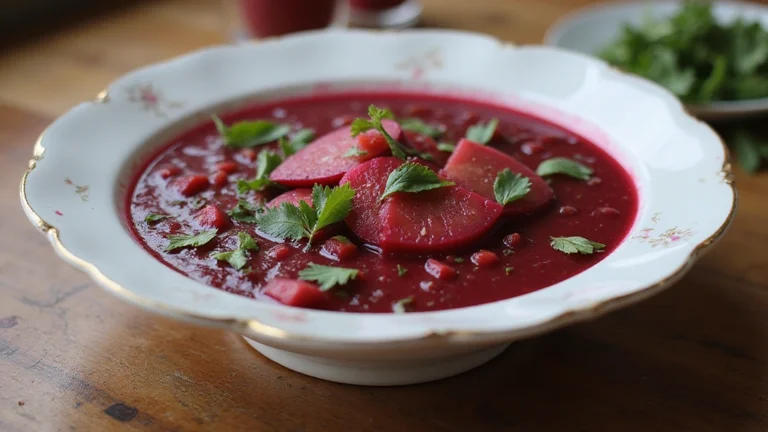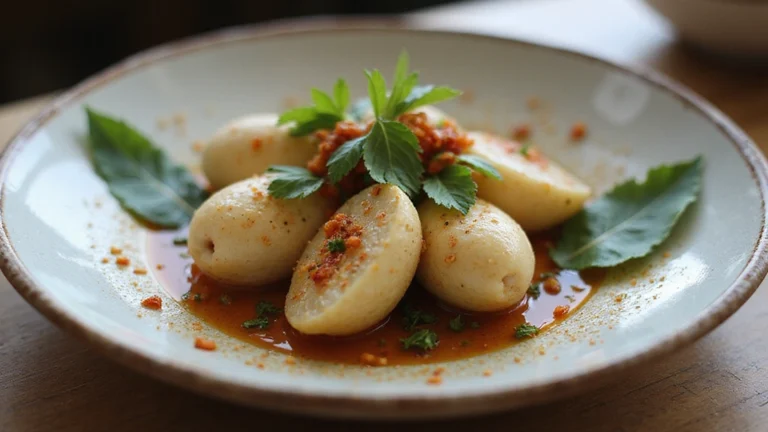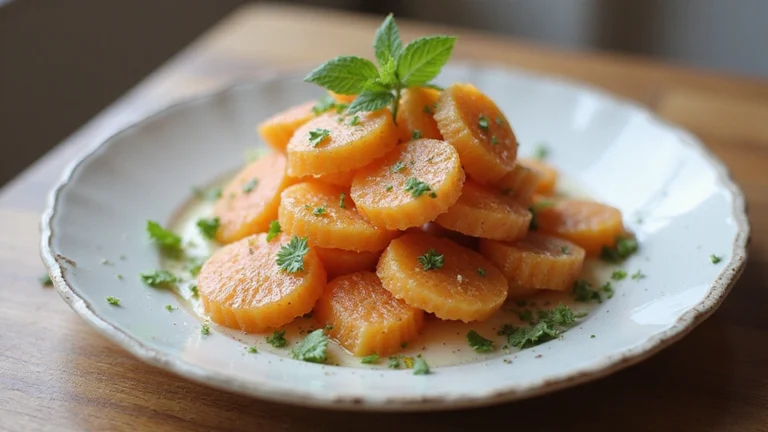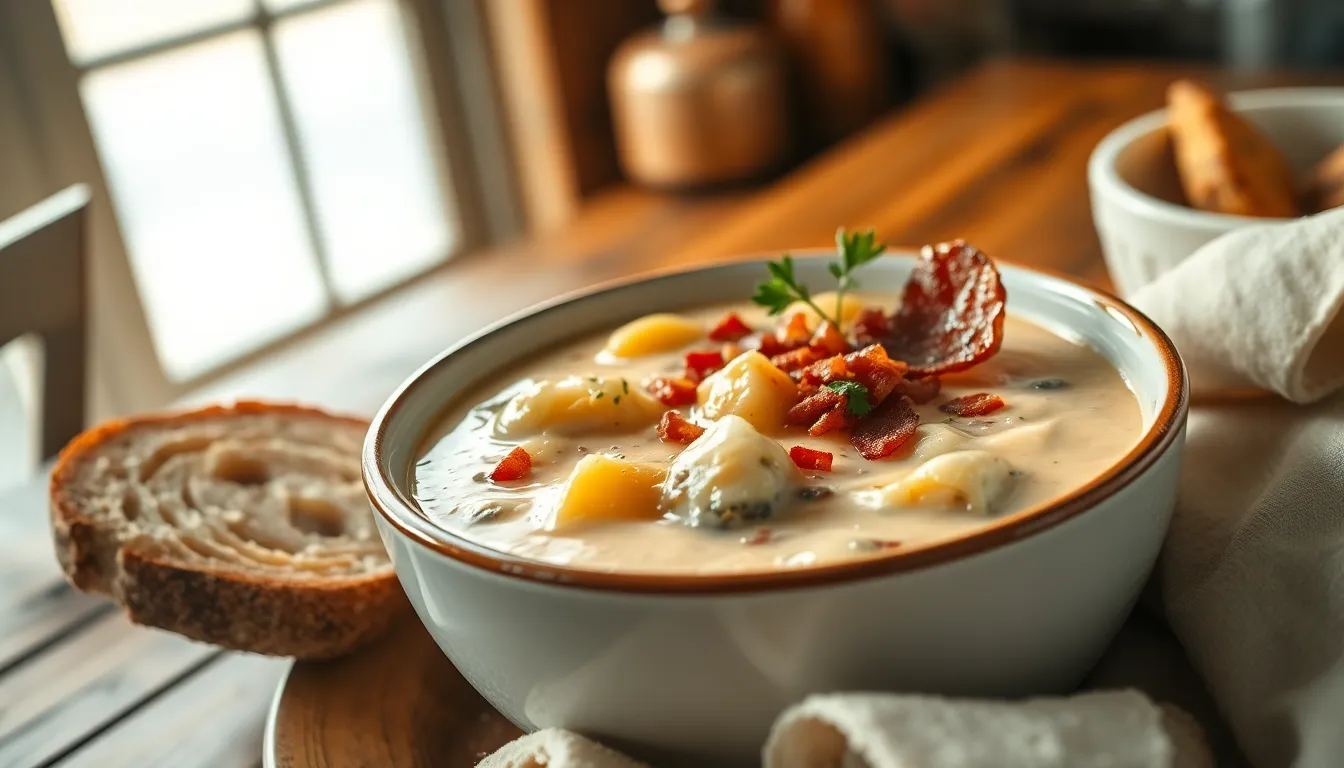
Craving a bowl of oyster chowder that’ll transport you to coastal bliss? This luxurious seafood classic combines the briny sweetness of fresh oysters with creamy richness that’s guaranteed to satisfy your comfort food cravings.
There’s something undeniably special about oyster chowder. Unlike its clam-based cousin, this delicacy showcases the delicate flavor of oysters while maintaining that velvety texture you expect from a proper chowder. Perfect for chilly evenings or whenever you’re yearning for a taste of the sea, this dish strikes the perfect balance between elegant and hearty.
You’ll be surprised at how simple it is to recreate restaurant-quality oyster chowder in your own kitchen. With just a handful of ingredients and about 30 minutes, you’ll be savoring spoonfuls of this creamy seafood treasure that’s been warming souls along American coastlines for generations.
The Comforting History Of Oyster Chowder
Oyster chowder traces its roots back to coastal communities where seafood was abundant and preservation methods were limited. Native Americans first introduced European settlers to oysters along the Atlantic coast in the 1700s. These early chowders were simple concoctions made in large cauldrons where cooks would layer ingredients including onions broth oysters and hardtack.
New England fishermen popularized oyster chowder as a hearty meal that could sustain them during long days at sea. The dish gained prominence in the 19th century when oysters were plentiful and inexpensive making them a protein source accessible to all social classes. Taverns throughout the Northeast served hot bowls of oyster chowder alongside fresh bread becoming a standard comfort food during cold winter months.
By the 1800s oyster chowder had become so beloved that it was traditionally served at Thanksgiving and Christmas celebrations throughout the American East Coast. Cookbooks from this era featured many variations with some recipes calling for milk while others used water as the base. The addition of cream—now considered essential to a proper oyster chowder—became standard practice in the late 19th century as dairy production increased.
The regional variations of oyster chowder reflect America’s diverse culinary industry. New England versions typically feature a creamy base with potatoes while Manhattan-style preparations incorporate tomatoes for a distinctive red broth. Southern oyster chowder often includes bacon and sometimes incorporates okra as a thickening agent showcasing the blending of African and European cooking traditions.
Today’s oyster chowder remains remarkably similar to historical recipes though modern versions might include wine butter or fresh herbs for enhanced flavor. The dish represents a direct connection to American culinary heritage reminding us how coastal communities transformed local ingredients into enduring comfort foods that continue to warm both body and soul centuries later.
Why You’ll Love This Oyster Chowder Recipe
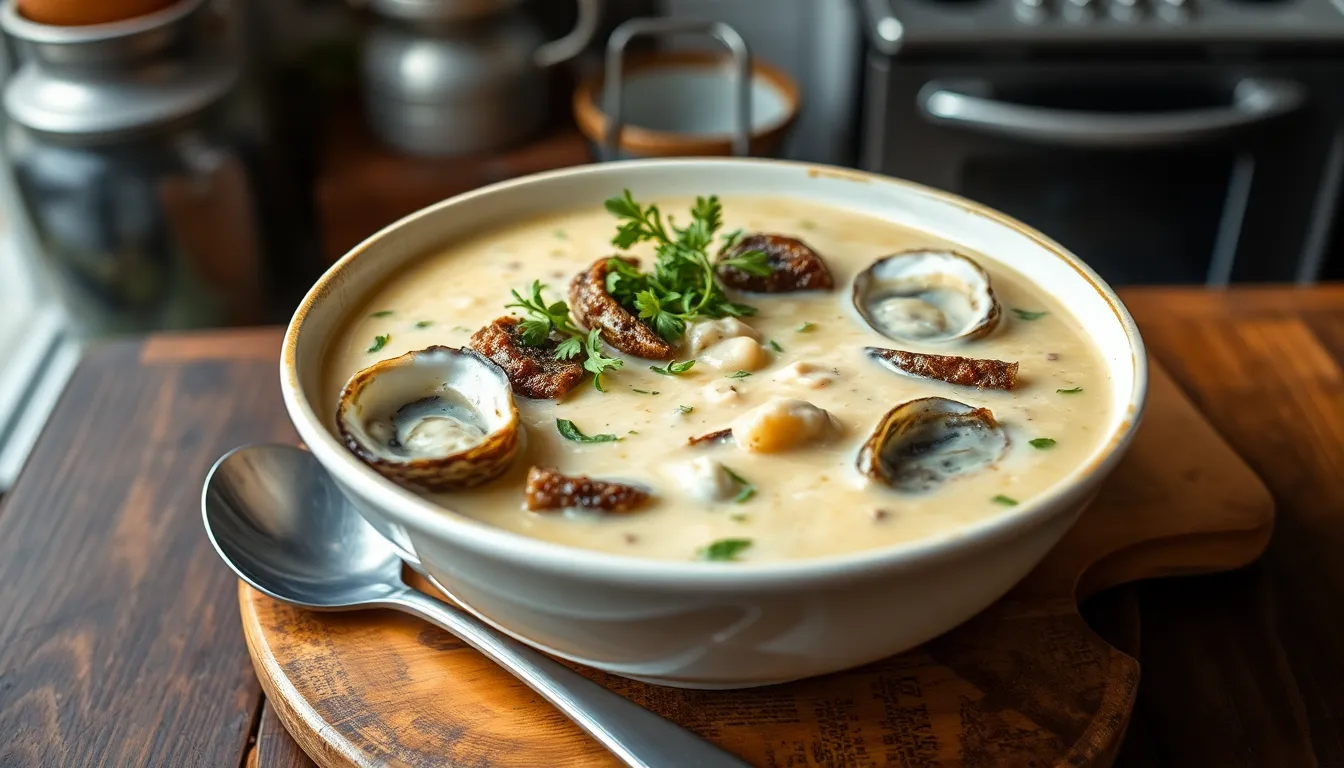
Rich Flavor with a Smoky Twist – This oyster chowder features smoked oysters that infuse the creamy base with unexpected depth. Unlike traditional recipes that rely on roux thickeners, the natural smokiness enhances every spoonful while maintaining a silky texture.
Quick and Convenient Preparation – You’ll appreciate how this dish comes together in just 50 minutes total—20 minutes of prep and 30 minutes of cooking time. This efficiency makes our oyster chowder perfect for busy weeknights when you crave something special without spending hours in the kitchen.
Nutritional Powerhouse – Your body will thank you for the impressive health benefits packed into each bowl. Oysters deliver exceptional zinc content that supports immune function, while their omega-3 fatty acids promote heart health. A typical serving provides approximately 10 grams of protein and contains around 175 calories per cup, making it satisfying without being heavy.
Versatile and Adaptable – This recipe welcomes customization based on your preferences. Add cod for extra protein, incorporate seasonal vegetables, or adjust the creaminess to your liking. The foundation remains deliciously consistent while allowing for personal touches.
Comforting Year-Round Appeal – Though traditionally enjoyed during colder months, this oyster chowder serves as a reminder of coastal pleasures any time of year. The harmonious balance of briny seafood, hearty potatoes, and creamy broth creates a comforting dish that satisfies on multiple sensory levels.
Equipment Needed
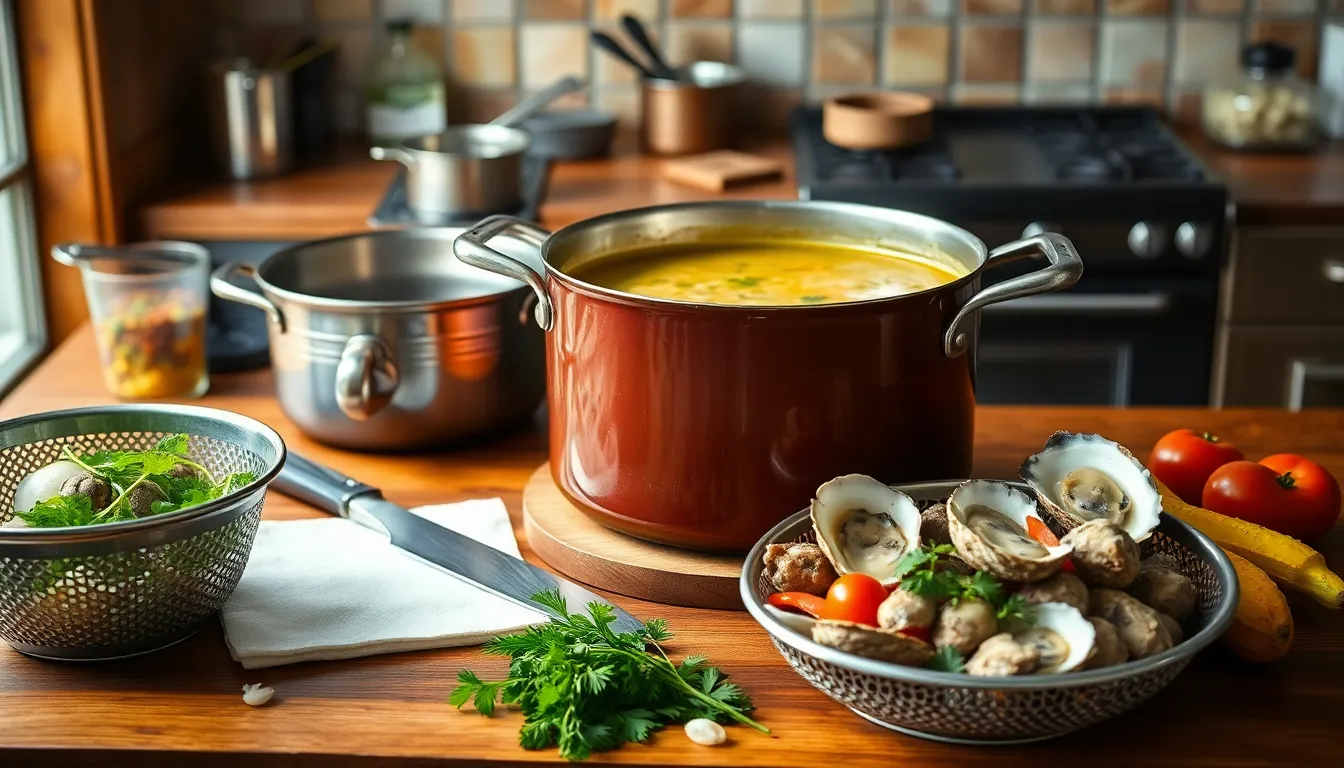
Before diving into your oyster chowder preparation, gather these essential kitchen tools to ensure a smooth cooking experience:
- Large soup pot with lid – A heavy-bottomed pot is ideal for even heat distribution and proper simmering of your chowder
- Sharp chef’s knife and cutting board – For precisely chopping vegetables and bacon
- Measuring cups and spoons – To accurately portion both dry and liquid ingredients
- Sauté pan or skillet – Used for rendering bacon fat and sautéing aromatics
- Vegetable peeler – For efficiently prepping potatoes
- Tongs – Helpful for handling oysters during shucking and cooking
- Sturdy metal cooking spoon – Essential for stirring your chowder without scratching your cookware
- Colander – Useful when working with fresh oysters to separate them from their liquor
While not strictly necessary, a food processor can save time by quickly chopping vegetables. Most home cooks can easily prepare this classic coastal dish with standard kitchen equipment, making oyster chowder an accessible comfort food even for those without specialized tools.
Ingredients
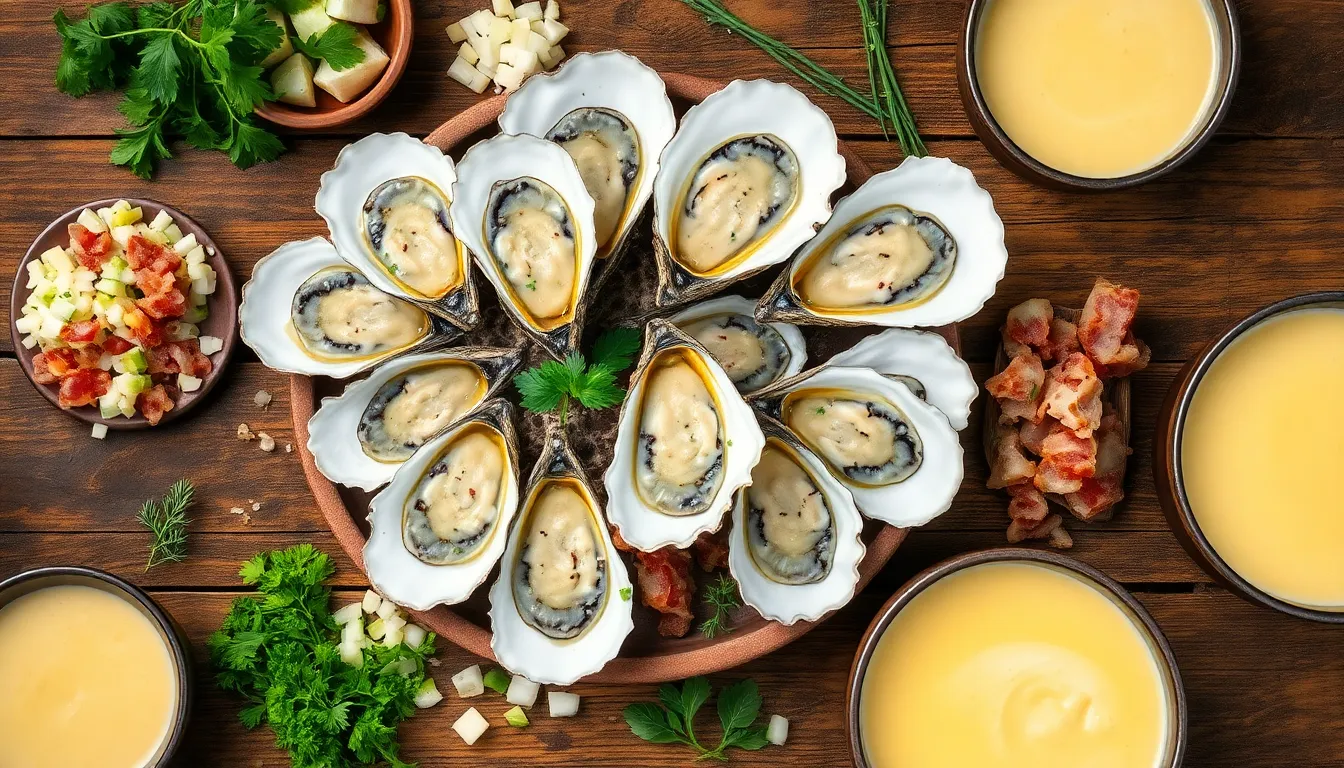
Creating classic oyster chowder requires simple yet high-quality ingredients that work together to produce a rich and flavorful dish. The recipe components can be divided into three key categories: the flavorful base, the star seafood element, and optional garnishes that enhance the final presentation.
For The Base
- 6-8 slices bacon, chopped
- 1 medium onion, finely diced
- 2 stalks celery, finely chopped
- 1 large carrot, finely diced
- 2 cloves garlic, minced
- 1 tablespoon fresh thyme leaves (or 1 teaspoon dried)
- 3 medium potatoes, peeled and cubed
- 2 cups seafood broth or clam juice (or reserved oyster liquor)
- 2 cups half and half (or 1 cup each milk and heavy cream)
- 1/4 cup dry white wine (optional)
- 1 teaspoon Worcestershire sauce
- Salt and white pepper to taste
- Dash of hot sauce (optional)
- 1/2 teaspoon celery salt
- 1 tablespoon fresh lemon juice
For The Seafood Component
- 1 pint fresh oysters (approximately 12-24 oysters), shucked with liquor reserved
- You can substitute 12-16 ounces of shucked oysters from seafood counter
- Pat oysters dry with paper towels before adding to chowder
- Consider cutting larger oysters into bite-sized pieces for even cooking
Optional Garnishes
- Reserved crispy bacon crumbles
- Crispy potato skins (seasoned and baked until golden)
- Fresh chopped Italian parsley
- Fresh thyme leaves
- Dash of smoked paprika or cayenne pepper
- Chopped green onions
- Crispy fried leeks
- Oyster crackers or crusty bread for serving
- Lemon wedges for squeezing
How To Prepare Fresh Oysters
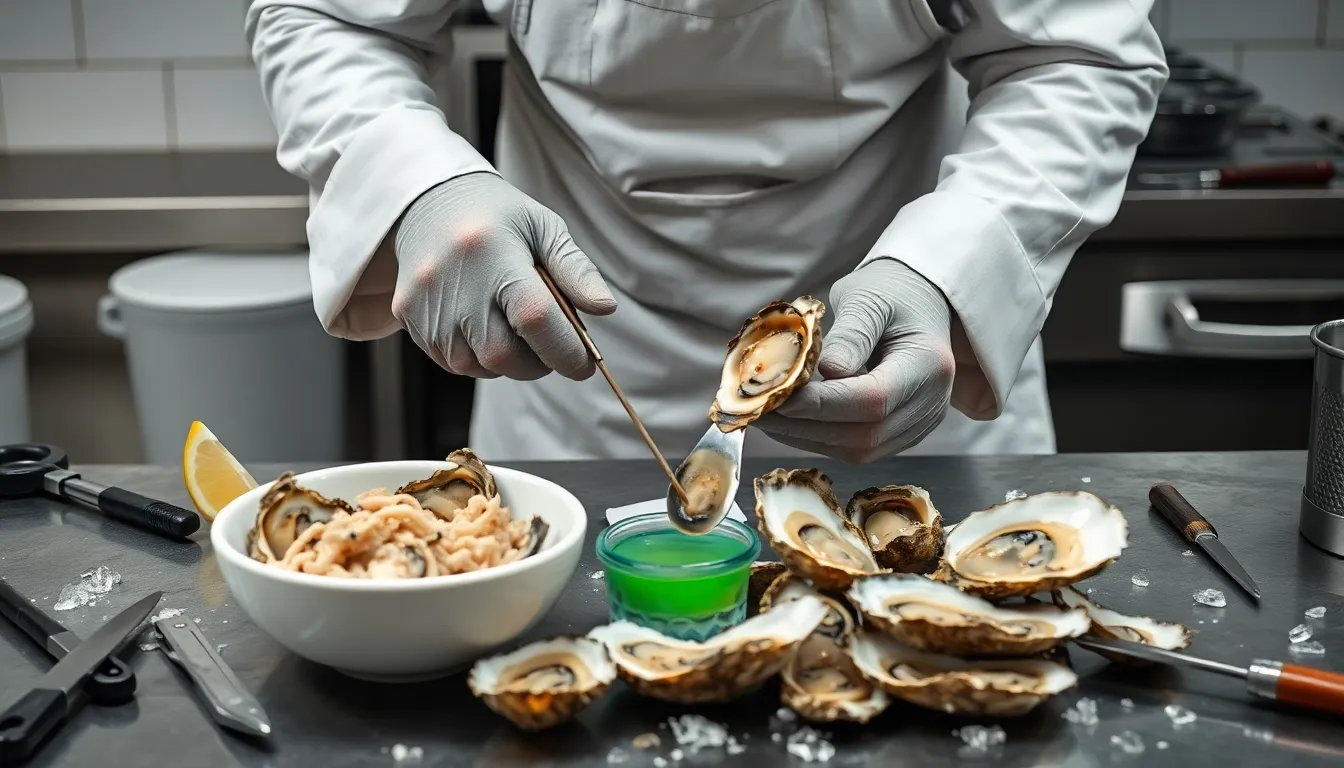
Working with fresh oysters might seem intimidating but mastering a few basic techniques will elevate your oyster chowder to restaurant quality. The right preparation method preserves the briny flavor and delicate texture that make oysters so prized in seafood dishes.
Shucking Oysters
Proper shucking requires the right tool and technique to safely access the meat without damaging it. Start by selecting a proper oyster knife with a short sturdy blade specifically designed for prying open oyster shells. Hold the oyster with its flat side facing up and the hinged end pointing toward your hand for optimal leverage. Protect your hand with a folded kitchen towel or specialized oyster glove to prevent injuries from slips.
Insert the knife blade firmly into the hinge of the oyster and apply gentle twisting pressure until you feel the shell pop open. Carefully slide the blade along the inside top shell to cut the adductor muscle that holds the shell closed. Remove the top shell slowly to preserve the flavorful oyster liquor contained in the bottom shell. This natural juice adds incredible depth to your chowder and should be collected and reserved.
Cleaning Oysters
Before shucking fresh oysters rinse them thoroughly under cold running water to remove any grit sand or debris from the outer shell. After successfully opening each oyster inspect it carefully for any small shell fragments that might have broken off during the shucking process. If necessary gently rinse the meat while it remains in the bottom shell taking special care not to lose the precious oyster liquor.
For oyster chowder preparation you’ll want to separate the meat from the shell by gently sliding a knife underneath the oyster. Transfer both the meat and liquor to a bowl until you’re ready to add them to your chowder. Fresh oysters require minimal cooking in the chowder base about 5-10 minutes or just until their edges begin to curl indicating they’re perfectly done without becoming tough or rubbery.
Step-By-Step Instructions
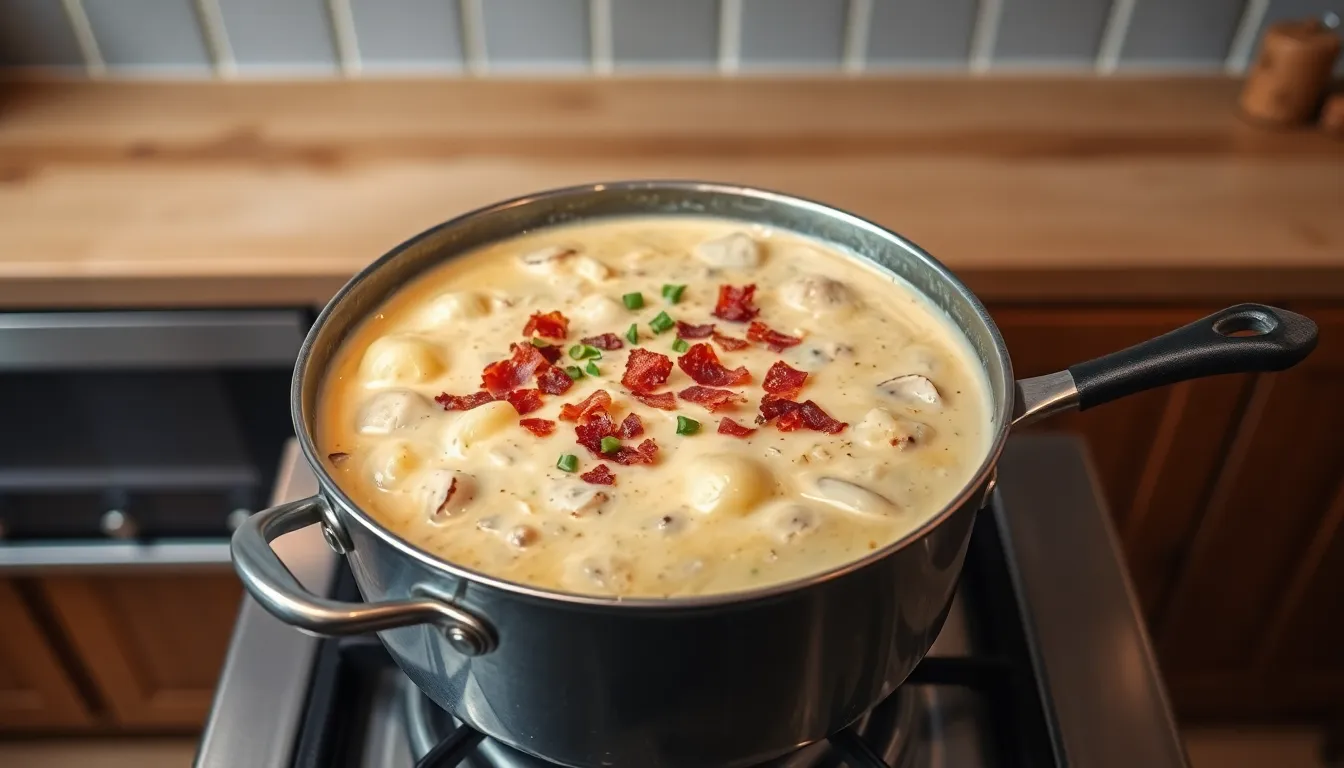
Follow these detailed instructions to create a rich and flavorful oyster chowder that balances delicate seafood flavors with creamy comfort. This methodical approach ensures perfect results every time.
Preparing The Base
Start by finely dicing your celery, carrots, and onions, either using a sharp knife or a food processor to save time.
Heat a medium-large saucepan over medium heat and cook the chopped bacon until it becomes crisp and releases its fat. Remove the crispy bacon pieces with tongs and set aside, leaving about 1-2 tablespoons of bacon grease in the pan.
Add your diced vegetables (celery, carrots, and onions) to the hot bacon grease and sauté them until they become tender but not browned, which takes approximately 5-7 minutes. Stir in minced garlic and fresh thyme, cooking for an additional minute to release their aromatic flavors.
Pour in the seafood broth or clam juice and add the diced potatoes to the vegetable mixture. Bring the liquid to a simmer and cook until the potatoes become just tender when pierced with a fork, about 10-20 minutes depending on how small you’ve cut them.
Create a roux to thicken your chowder by melting butter in a separate small pan and whisking in flour until it turns light brown. Gradually incorporate this roux into your simmering base, stirring constantly to prevent any lumps from forming.
Adding The Oysters
Drain your oysters through a colander, making sure to collect the precious oyster liquor in a bowl beneath. Strain this collected liquor through a piece of cheesecloth to remove any grit or shell fragments before adding it to your chowder base for enhanced flavor.
Chop the oysters coarsely on a cutting board and add them to the soup after the potatoes have softened. Cook the mixture gently for 5-10 minutes, watching carefully for the edges of the oysters to just begin curling, which indicates they’re done.
Pour in the cream or half-and-half at this stage, stirring gently to incorporate it into the chowder. Heat the mixture through without allowing it to reach a full boil, which would risk curdling the dairy and toughening the oysters.
Final Seasoning
Return the reserved crispy bacon pieces to the chowder, stirring them in to distribute their smoky flavor throughout the soup. These bacon bits provide wonderful textural contrast to the creamy base and tender oysters.
Season your chowder with salt and freshly ground black pepper to taste, keeping in mind that oysters naturally contribute saltiness to the dish. Add a light sprinkle of smoked paprika for subtle depth if desired.
Finish the chowder with a handful of freshly chopped herbs such as parsley or chives, stirring them in just before serving. Allow the soup to simmer for just 2-3 minutes after final seasoning adjustments, giving the flavors time to meld without overcooking your carefully prepared ingredients.
Ladle the hot chowder into warmed bowls for immediate serving, as this dish is at its most delicious when fresh from the pot.
Serving Suggestions
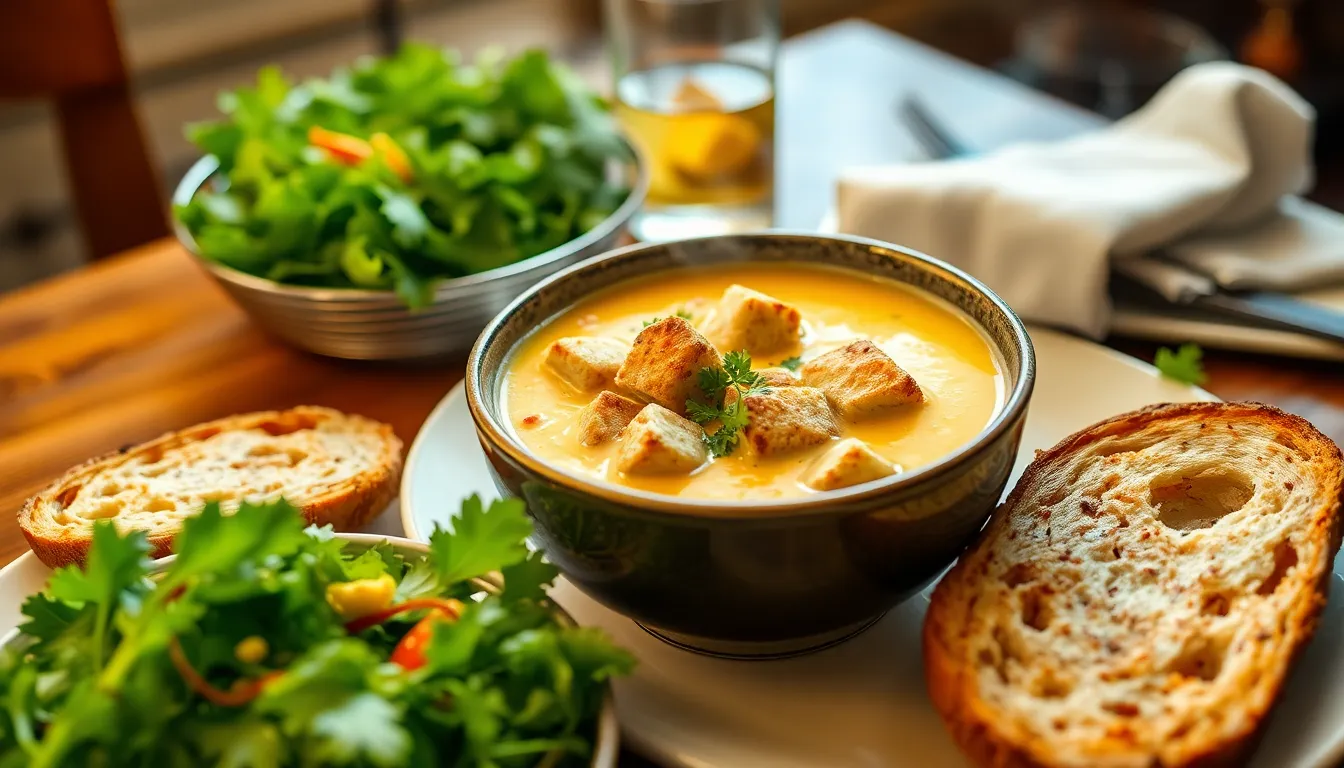
Your oyster chowder deserves perfect accompaniments that enhance its briny richness. Here are delicious pairings to elevate your chowder experience:
Bread Options
Crusty bread or fresh baguettes make ideal companions for oyster chowder as they soak up the flavorful broth. Break off pieces and dip them into your chowder to capture every drop of the creamy goodness. Oyster crackers or herbed croutons provide a satisfying crunch that contrasts beautifully with the chowder’s velvety texture while adding another layer of flavor.
Salad Pairings
Balance the richness of oyster chowder with a crisp fresh salad. A simple green salad with light vinaigrette dressing offers refreshing contrast to the chowder’s creaminess. Coleslaw works wonderfully too providing both crunch and acidity that cuts through the richness of the soup making each spoonful taste brand new.
Seafood Companions
Maintain the coastal theme by serving your oyster chowder alongside complementary seafood dishes. Shrimp scampi with its garlicky butter sauce creates a delightful seafood feast when paired with your chowder. Crab cakes offer textural contrast and enhance the overall seafood experience allowing diners to enjoy different preparations of ocean flavors in one meal.
Southern Comfort Pairings
For a heartier meal embrace Southern comfort food traditions. Cornbread brings sweet notes that complement the savory chowder beautifully. Buttermilk biscuits serve as excellent vehicles for sopping up every last bit of the flavorful broth. Fried chicken or meatloaf transform your chowder from a starter into part of a soul-satisfying feast that celebrates classic American cooking.
Vegetable Sides
Add nutritional balance with vegetable sides that harmonize with oyster chowder. Southern-style green beans seasoned with bacon offer savory notes that echo the chowder’s depth. Honey glazed carrots contribute sweet elements that balance the briny oyster flavor creating a more rounded meal experience.
Special Touches
Elevate your presentation by topping each bowl with crunchy croutons and a sprinkle of fresh parsley before serving. Consider offering small shots of sherry alongside the chowder allowing guests to add a splash to their bowls. This traditional addition imparts a subtle boozy warmth that amplifies the chowder’s complex flavor profile without overwhelming the delicate oyster taste.
Storage And Reheating Tips
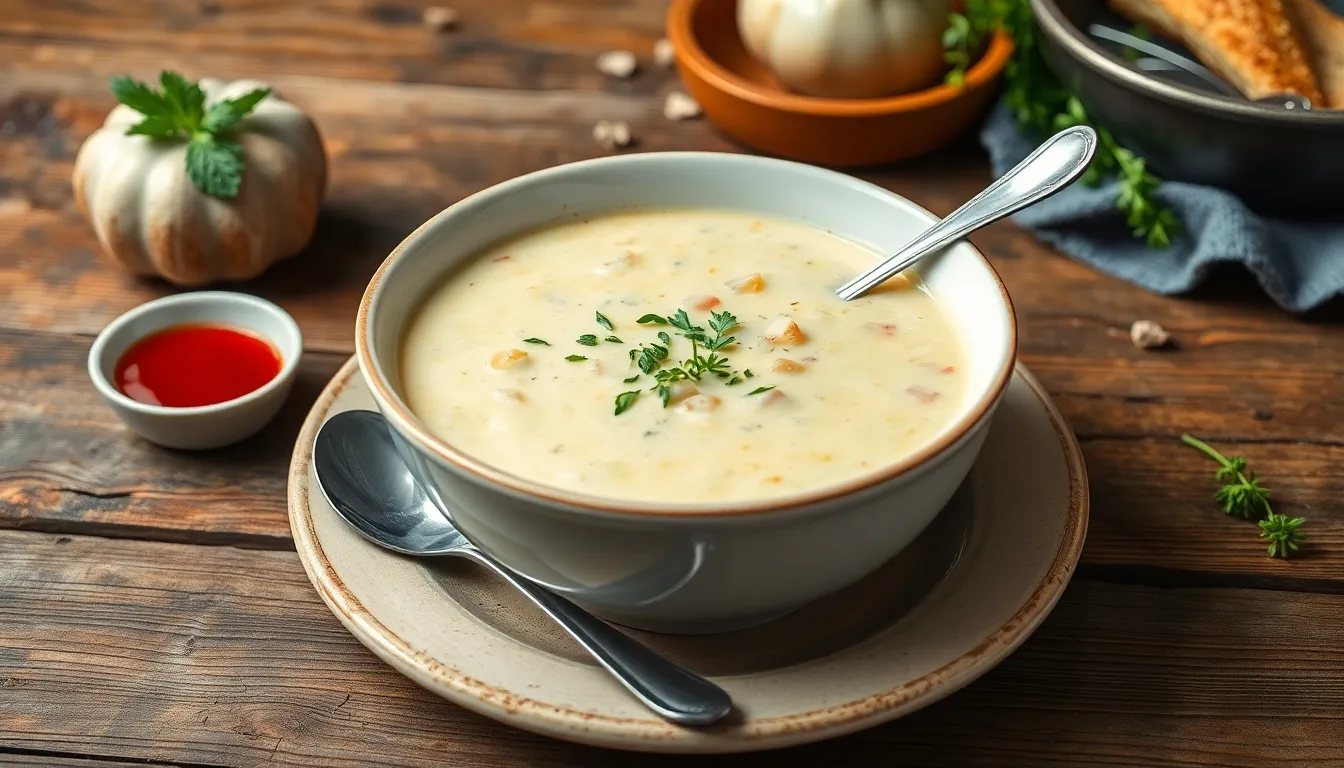
Proper storage and reheating techniques are essential for maintaining the delicate flavors and creamy texture of your oyster chowder. Follow these guidelines to enjoy your chowder at its best even after the initial serving.
Refrigerating Your Chowder
Store your oyster chowder in an airtight container in the refrigerator for optimal freshness. The chowder will remain good for 3-4 days when properly refrigerated. For best quality, try to consume the chowder within 2 days, as the delicate oyster flavors begin to diminish after this time.
If you’re using fresh oysters for your recipe, remember they should only be stored in the refrigerator for up to 2 days before cooking to ensure safety and optimal flavor.
Freezing Considerations
While technically possible, freezing oyster chowder is generally not recommended. The texture of ingredients like potatoes significantly degrades upon thawing and reheating. The creamy base may also separate when frozen and thawed, resulting in a less appealing consistency.
Should you need to freeze portions, use freezer-safe containers and leave some space at the top for expansion. Label containers with the date to track freshness.
Reheating Methods
Gentle reheating is crucial for maintaining your chowder’s creamy texture. The stovetop method produces the best results for oyster chowder:
- Transfer the desired portion to a heavy-bottomed saucepan
- Heat over low to medium-low heat
- Stir occasionally to ensure even warming
- Heat until just warmed through (approximately 10-15 minutes)
- Avoid bringing the chowder to a boil, which can cause dairy separation
Microwave reheating works in a pinch but requires careful attention:
- Place chowder in a microwave-safe bowl
- Cover loosely to prevent splattering
- Heat in 30-second intervals at 50% power
- Stir between intervals for even heating
- Continue until just warmed through
Revitalizing Leftover Chowder
Leftover chowder sometimes thickens in the refrigerator as the potatoes absorb liquid. Add a small amount of seafood stock, milk, or cream while reheating to restore the original consistency. Adjust seasonings after reheating, as flavors can become more concentrated during storage.
A fresh garnish of herbs or a few drops of hot sauce can reinvigorate day-old chowder, making it taste nearly as good as freshly made.
Recipe Variations
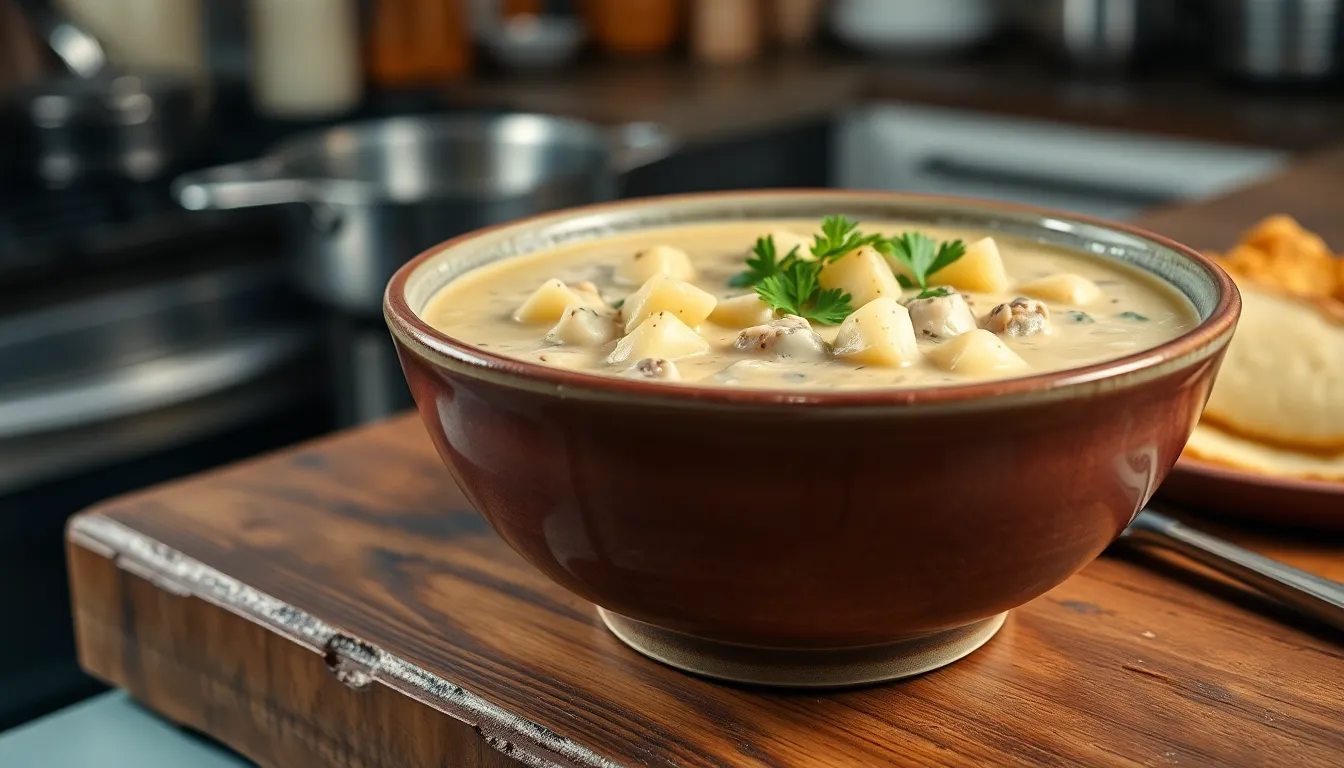
Oyster chowder comes in several delicious variations that highlight different cooking techniques and regional flavor profiles. Each style offers a unique take on this classic seafood dish while maintaining the delicate briny essence of fresh oysters.
Creamy New England Style
This rich buttery version represents the classic interpretation of oyster chowder beloved throughout the Northeast. Begin by rendering chopped bacon or salted pork until crisp to create a flavorful foundation. Sauté a mixture of diced onions celery and garlic in the rendered fat until soft and translucent. Add cubed white potatoes which provide essential body and starch to the chowder. Pour in a combination of reserved oyster liquor and seafood stock bringing everything to a gentle simmer until potatoes become tender. Finish with cream or half-and-half for that signature luxurious texture. Season with white pepper Worcestershire sauce cayenne lemon juice and smoked paprika for a perfectly balanced flavor profile. Add the oysters last cooking them briefly in the hot liquid just until their edges begin to curl. Sprinkle with chopped Italian parsley before serving for a fresh aromatic finish.
Ingredients:
- 6-8 slices bacon diced
- 1 medium onion finely chopped
- 2 celery stalks diced
- 2 garlic cloves minced
- 2 cups white potatoes cubed
- 1 cup reserved oyster liquor
- 2 cups seafood broth
- 1 pint fresh oysters
- 1 cup cream or half-and-half
- 1 teaspoon white pepper
- 1 tablespoon Worcestershire sauce
- Pinch of cayenne pepper
- 1 tablespoon fresh lemon juice
- ½ teaspoon smoked paprika
- Fresh Italian parsley for garnish
Clear Broth Style
This lighter approach showcases the natural flavors of oysters without the richness of cream. Start by heating bacon fat or butter in a large pot to sauté finely diced onions celery and carrots until softened. Add diced potatoes and a clear seafood stock or clam juice bringing the mixture to a simmer. Cook until potatoes become tender but still hold their shape. The broth remains translucent allowing the briny essence of the oysters to shine through. Add freshly shucked oysters with their liquor during the final minutes of cooking. This style results in a cleaner tasting chowder that highlights the delicate seafood flavor without the heaviness of cream. Finish with a sprinkle of fresh herbs like thyme or parsley to brighten the dish before serving.
Spicy Cajun Version
This bold Southern interpretation kicks up the heat with classic Cajun flavors and spices. Begin by making a dark roux with equal parts butter and flour or use bacon fat as your flavor base. Add the “holy trinity” of Cajun cooking – diced onions bell peppers and celery – along with minced garlic and sauté until fragrant. Season generously with smoked paprika cayenne pepper hot sauce and Worcestershire sauce for that signature Louisiana heat. Incorporate diced potatoes oyster liquor and seafood stock allowing everything to simmer until potatoes become tender. Heavy cream or milk balances the spiciness while maintaining a luxurious mouthfeel. Gently add oysters cooking just until their edges curl. Top each serving with crispy bacon crumbles potato skin crisps and fresh herbs like chives for textural contrast. This version delivers a perfect balance of seafood sweetness creamy richness and spicy warmth that embodies Gulf Coast cooking traditions.
Chef’s Tips For Perfect Oyster Chowder

Creating restaurant-quality oyster chowder at home becomes effortless when you master these professional techniques. These expert tips will elevate your chowder from good to exceptional by preserving the delicate flavors of oysters while creating a perfectly balanced dish.
Harness the Power of Oyster Liquor
Never discard the precious oyster liquor when shucking fresh oysters. This flavorful juice contains concentrated oceanic essence that intensifies your chowder’s brininess. Adding this natural liquid reduces the need for additional salt while amplifying authentic oyster flavor throughout the broth.
Perfect Your Timing
Oysters require minimal cooking time to maintain their delicate texture. Add them during the final few minutes of preparation and watch carefully for the edges to curl slightly—this visual cue indicates they’re perfectly cooked. Overcooking transforms tender oysters into rubbery disappointments, so exercise restraint with cooking time.
Layer Flavors Strategically
Begin your chowder by browning bacon until crisp, then use the rendered fat to sauté aromatics like onions, celery, and leeks. This foundational flavor base creates depth that supports rather than overwhelms the oysters. Reserve some crispy bacon bits for garnishing to provide textural contrast against the creamy soup.
Master the Roux Technique
A properly executed roux—equal parts flour and butter cooked together—provides the ideal velvety thickness for oyster chowder. Cook this mixture until it reaches a light golden color before gradually incorporating your liquids. This technique prevents lumps while creating silky consistency throughout your chowder.
Balance Creaminess Carefully
The choice between heavy cream, half-and-half, or milk significantly impacts your chowder’s richness. Half-and-half offers ideal middle ground, providing sufficient creaminess without masking the oysters’ subtle flavor. Start with less dairy than you think necessary—you can always add more to achieve your preferred consistency.
Season with Restraint
Exercise caution with salt since oyster liquor and bacon already contribute important saltiness. Season incrementally, tasting frequently to maintain proper balance. Overzealous seasoning easily overwhelms the delicate oyster flavor that makes this chowder special.
Enhance with Fresh Herbs and Garnishes
Fresh herbs like thyme, bay leaves, and chives introduce aromatic complexity that complements oysters beautifully. Finish each serving with carefully selected garnishes—crispy bacon bits, snipped chives, or seaweed flakes like dulse add visual appeal while introducing textural variety and flavor accents.
Consider Oceanic Additions
Amplify the maritime character of your chowder with subtle oceanic elements. A small amount of seaweed butter or dulse flakes introduces authentic sea flavors that enhance the oysters without overwhelming them. These additions create remarkable depth while maintaining the chowder’s traditional comfort food appeal.
Conclusion
Oyster chowder stands as a testament to America’s rich coastal heritage while offering a gourmet experience you can easily create at home. This versatile dish balances delicate briny flavors with comforting creaminess that satisfies year-round.
Whether you prefer the classic New England style a spicy Cajun twist or a clear broth variation the fundamentals remain the same – fresh ingredients thoughtful preparation and attention to detail will yield restaurant-quality results in your kitchen.
Armed with the right tools techniques and a bit of confidence you’ll discover that oyster chowder isn’t just a meal but a culinary tradition worth preserving and sharing. Give this seafood treasure a place in your cooking repertoire and watch as it becomes a requested favorite for years to come.
Frequently Asked Questions
What makes oyster chowder different from clam chowder?
Oyster chowder has a more delicate flavor profile and velvety texture compared to clam chowder. While both are creamy seafood soups, oyster chowder highlights the subtle briny sweetness of oysters rather than the more pronounced flavor of clams. The oysters also create a naturally silkier consistency in the broth when cooked properly.
How long does it take to make oyster chowder at home?
Homemade oyster chowder takes approximately 30-50 minutes to prepare from start to finish. The quick cooking time makes it perfect for weeknight dinners despite its restaurant-quality taste. Most of the time is spent preparing the base and allowing the flavors to meld, while the oysters themselves cook very quickly.
What are the health benefits of eating oyster chowder?
Oyster chowder is nutritionally rich, providing approximately 10 grams of protein and 175 calories per serving. Oysters are exceptionally high in zinc, which supports immune function, and contain beneficial omega-3 fatty acids. Even in a creamy base, the seafood delivers significant nutritional value including important minerals and vitamins.
What equipment do I need to make oyster chowder?
Basic kitchen equipment is sufficient: a large soup pot, chef’s knife, measuring cups, sauté pan, vegetable peeler, tongs, cooking spoon, and colander. A food processor is optional but helpful for chopping vegetables. No specialized tools are required unless you’re shucking fresh oysters yourself, in which case an oyster knife is necessary.
How do I properly shuck fresh oysters for chowder?
To shuck oysters, you’ll need an oyster knife and a kitchen towel. Hold the oyster flat-side up, wrapped in the towel. Insert the knife at the hinge, twist to pop it open, then cut the muscle connecting the oyster to the shell. Collect the flavorful oyster liquor (natural juice) to add to your chowder for extra flavor.
Can I freeze leftover oyster chowder?
While technically possible, freezing oyster chowder is not recommended. The dairy components tend to separate when thawed, affecting the texture and consistency. If you must freeze it, do so without the cream, then add fresh cream when reheating. For best quality, refrigerate leftovers in an airtight container and consume within 2-4 days.
What are the main ingredients needed for classic oyster chowder?
Classic oyster chowder requires bacon, onion, celery, carrots, garlic, thyme, potatoes, seafood broth, and half-and-half for the base. Fresh oysters are the star ingredient, while butter and flour create the thickening roux. Salt, pepper, and optional garnishes like parsley or oyster crackers complete the dish.
What’s the best way to reheat oyster chowder?
Reheat oyster chowder gently on the stovetop over medium-low heat, stirring frequently to prevent the dairy from separating. Add a splash of broth or cream if it’s too thick. Avoid boiling, which can cause the oysters to become tough and the cream to break. Microwave reheating is possible but requires short intervals and frequent stirring.
What are some regional variations of oyster chowder?
Regional variations include the creamy New England style with a rich, buttery base; the clear broth style that showcases oysters’ natural flavor without cream; and the spicy Cajun version with bold seasonings like cayenne and paprika. The Manhattan style incorporates tomatoes for a red broth, while Pacific Northwest versions might include local ingredients like wild mushrooms.
What should I serve with oyster chowder?
Serve oyster chowder with crusty bread or baguettes for dipping. Balance the richness with a light green salad or coleslaw. For a seafood-themed meal, pair with shrimp scampi or crab cakes. Southern accompaniments like cornbread or buttermilk biscuits work beautifully. For an elegant touch, offer small shots of sherry alongside to enhance the chowder’s complex flavors.
